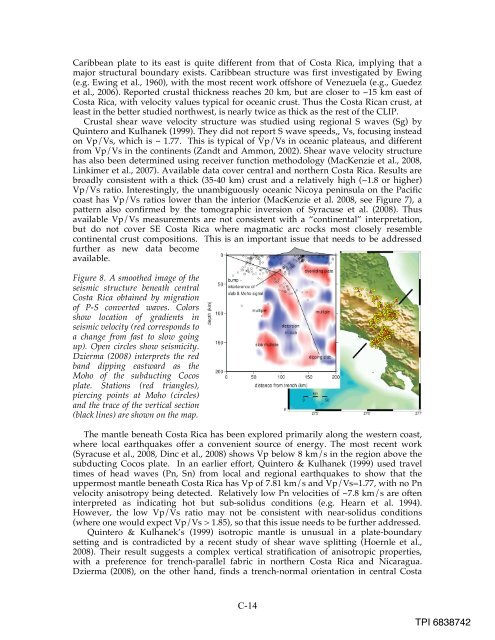TROPICS
TROPICS
TROPICS
You also want an ePaper? Increase the reach of your titles
YUMPU automatically turns print PDFs into web optimized ePapers that Google loves.
Caribbean plate to its east is quite different from that of Costa Rica, implying that a<br />
major structural boundary exists. Caribbean structure was first investigated by Ewing<br />
(e.g. Ewing et al., 1960), with the most recent work offshore of Venezuela (e.g., Guedez<br />
et al., 2006). Reported crustal thickness reaches 20 km, but are closer to ~15 km east of<br />
Costa Rica, with velocity values typical for oceanic crust. Thus the Costa Rican crust, at<br />
least in the better studied northwest, is nearly twice as thick as the rest of the CLIP.<br />
Crustal shear wave velocity structure was studied using regional S waves (Sg) by<br />
Quintero and Kulhanek (1999). They did not report S wave speeds,, Vs, focusing instead<br />
on Vp/Vs, which is ~ 1.77. This is typical of Vp/Vs in oceanic plateaus, and different<br />
from Vp/Vs in the continents (Zandt and Ammon, 2002). Shear wave velocity structure<br />
has also been determined using receiver function methodology (MacKenzie et al., 2008,<br />
Linkimer et al., 2007). Available data cover central and northern Costa Rica. Results are<br />
broadly consistent with a thick (35-40 km) crust and a relatively high (~1.8 or higher)<br />
Vp/Vs ratio. Interestingly, the unambiguously oceanic Nicoya peninsula on the Pacific<br />
coast has Vp/Vs ratios lower than the interior (MacKenzie et al. 2008, see Figure 7), a<br />
pattern also confirmed by the tomographic inversion of Syracuse et al. (2008). Thus<br />
available Vp/Vs measurements are not consistent with a “continental” interpretation,<br />
but do not cover SE Costa Rica where magmatic arc rocks most closely resemble<br />
continental crust compositions. This is an important issue that needs to be addressed<br />
further as new data become<br />
available.<br />
Figure 8. A smoothed image of the<br />
seismic structure beneath central<br />
Costa Rica obtained by migration<br />
of P-S converted waves. Colors<br />
show location of gradients in<br />
seismic velocity (red corresponds to<br />
a change from fast to slow going<br />
up). Open circles show seismicity.<br />
Dzierma (2008) interprets the red<br />
band dipping eastward as the<br />
Moho of the subducting Cocos<br />
plate. Stations (red triangles),<br />
piercing points at Moho (circles)<br />
and the trace of the vertical section<br />
(black lines) are shown on the map.<br />
The mantle beneath Costa Rica has been explored primarily along the western coast,<br />
where local earthquakes offer a convenient source of energy. The most recent work<br />
(Syracuse et al., 2008, Dinc et al., 2008) shows Vp below 8 km/s in the region above the<br />
subducting Cocos plate. In an earlier effort, Quintero & Kulhanek (1999) used travel<br />
times of head waves (Pn, Sn) from local and regional earthquakes to show that the<br />
uppermost mantle beneath Costa Rica has Vp of 7.81 km/s and Vp/Vs=1.77, with no Pn<br />
velocity anisotropy being detected. Relatively low Pn velocities of ~7.8 km/s are often<br />
interpreted as indicating hot but sub-solidus conditions (e.g. Hearn et al. 1994).<br />
However, the low Vp/Vs ratio may not be consistent with near-solidus conditions<br />
(where one would expect Vp/Vs > 1.85), so that this issue needs to be further addressed.<br />
Quintero & Kulhanek’s (1999) isotropic mantle is unusual in a plate-boundary<br />
setting and is contradicted by a recent study of shear wave splitting (Hoernle et al.,<br />
2008). Their result suggests a complex vertical stratification of anisotropic properties,<br />
with a preference for trench-parallel fabric in northern Costa Rica and Nicaragua.<br />
Dzierma (2008), on the other hand, finds a trench-normal orientation in central Costa<br />
C-14<br />
TPI 6838742
















